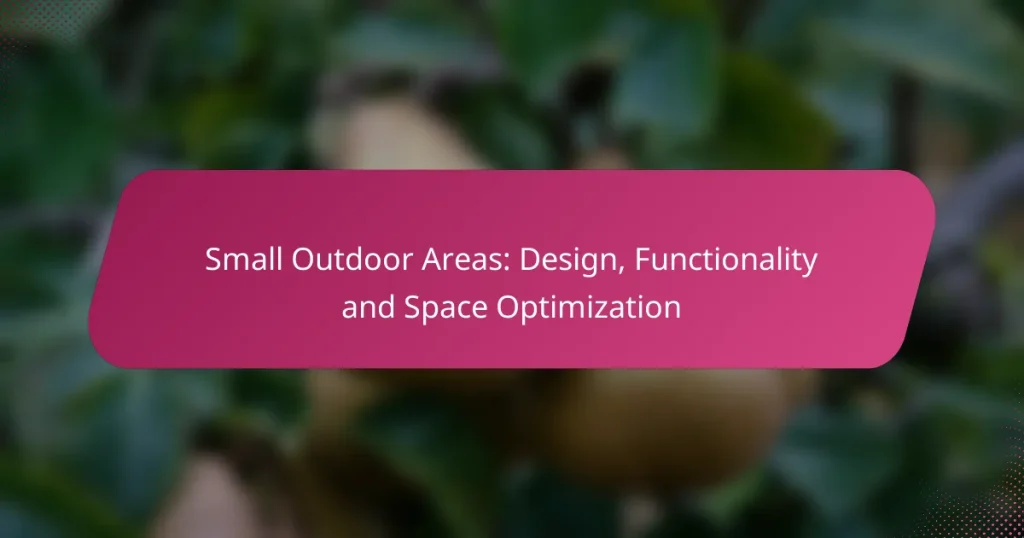Improving your outdoor space can significantly enhance both its beauty and functionality, making it a perfect retreat for relaxation and entertainment. In Los Angeles, popular enhancements include landscaping, patio installations, and outdoor lighting, all designed to complement the local climate. By creating distinct areas for various activities and incorporating comfortable furniture, you can transform your yard or patio into a versatile haven. It’s essential to consider your budget, as costs can vary based on the scope of the project and materials used.
Landscaping Trends: Sustainability, Color Schemes and Design Innovations
Small Outdoor Areas: Design, Functionality and Space Optimization
What are the best outdoor space improvements in Los Angeles?
The best outdoor space improvements in Los Angeles focus on enhancing aesthetics, functionality, and comfort. Key options include landscaping enhancements, patio installations, outdoor lighting solutions, deck construction, and garden design services, all tailored to the local climate and lifestyle.
Landscaping enhancements
Landscaping enhancements involve designing and planting greenery that complements your outdoor space. In Los Angeles, consider drought-resistant plants such as succulents and native species to reduce water usage and maintenance costs.
Incorporating features like pathways, decorative stones, or mulch can improve the visual appeal and functionality of your yard. Aim for a balanced layout that provides both beauty and practicality, ensuring easy access and maintenance.
Patio installation
Patio installation creates a designated area for relaxation and entertainment. Options range from concrete and pavers to natural stone, with costs varying widely based on materials and design complexity.
Consider the size and shape of your outdoor space when designing your patio. A well-planned patio can enhance your outdoor experience, providing a comfortable spot for gatherings or quiet evenings under the stars.
Outdoor lighting solutions
Outdoor lighting solutions improve safety and ambiance in your outdoor areas. Options include pathway lights, string lights, and spotlights, which can highlight landscaping features or provide illumination for gatherings.
When selecting outdoor lighting, consider energy-efficient LED options to reduce electricity costs. Proper placement is crucial; ensure lights are positioned to avoid glare while effectively illuminating key areas.
Deck construction
Deck construction adds usable space and can significantly enhance your outdoor living area. Choose materials like wood, composite, or PVC, each offering different aesthetics and maintenance requirements.
When planning a deck, consider its size and elevation to maximize views and sunlight exposure. Local building codes may require permits, so check regulations before starting your project.
Garden design services
Garden design services help create visually appealing and functional gardens tailored to your preferences. Professionals can assist in selecting plants, layout, and features that suit your lifestyle and the local climate.
Investing in garden design can save time and ensure a cohesive look. Consider hiring a designer if you want a unique garden that reflects your personal style while being sustainable and easy to maintain.
How can I increase my outdoor space’s functionality?
To enhance your outdoor space’s functionality, focus on creating distinct areas for various activities, incorporating effective storage solutions, and adding comfortable furniture. These improvements can transform your yard or patio into a versatile area for relaxation, entertainment, and organization.
Creating designated zones
Designating specific zones in your outdoor space helps maximize its use. Consider areas for dining, lounging, gardening, and play. Use visual dividers like planters, outdoor rugs, or trellises to clearly define each zone.
When planning these zones, think about how you will use the space throughout the day. For instance, a shaded area for midday relaxation can be complemented by a sunny spot for evening gatherings. This approach ensures that each zone serves a distinct purpose while maintaining a cohesive look.
Incorporating storage solutions
Effective storage solutions are essential for keeping your outdoor space organized and functional. Consider options like benches with hidden storage, outdoor cabinets, or vertical shelving to maximize space. These solutions help keep tools, cushions, and other items neatly stored away.
When selecting storage, choose weather-resistant materials to ensure durability. For example, resin or treated wood can withstand the elements better than untreated materials. Regularly assess your storage needs to adapt to changing seasons or activities.
Adding outdoor furniture
Adding outdoor furniture enhances comfort and usability in your outdoor space. Choose pieces that fit the designated zones you’ve created, such as dining sets for eating areas or lounge chairs for relaxation spots. Look for weather-resistant options to ensure longevity.
Consider the scale of your furniture in relation to your space. Oversized pieces can make a small area feel cramped, while appropriately sized items can create an inviting atmosphere. Aim for a balance between style and functionality, ensuring that your furniture complements the overall design of your outdoor space.
What are the costs associated with outdoor improvements?
The costs associated with outdoor improvements can vary widely based on the type of project, materials used, and local labor rates. Homeowners should budget for landscaping, patio installation, and lighting systems, each of which has its own pricing structure and considerations.
Average landscaping costs
Landscaping costs typically range from a few hundred to several thousand dollars, depending on the complexity of the design and the materials chosen. Basic lawn care and planting may cost around $1,000 to $3,000, while more elaborate designs with hardscaping can exceed $10,000.
When planning landscaping, consider factors such as soil quality, plant selection, and irrigation systems. Hiring a professional can increase costs but may provide better long-term results.
Patio installation pricing
The cost of patio installation can vary significantly based on size, materials, and design. On average, homeowners can expect to pay between $2,000 and $5,000 for a basic patio, with high-end materials like natural stone pushing costs to $10,000 or more.
It’s essential to factor in additional expenses such as site preparation, drainage solutions, and labor. Opting for DIY installation can save money but requires time and skill.
Lighting system expenses
Outdoor lighting systems can range from $500 for basic setups to several thousand dollars for extensive installations. The cost will depend on the type of fixtures, the number of lights, and the complexity of the wiring.
When planning outdoor lighting, consider energy-efficient options like LED fixtures, which can reduce long-term electricity costs. Hiring an electrician for installation can add to the upfront cost but ensures safety and compliance with local codes.
What permits are required for outdoor renovations in California?
In California, outdoor renovations often require specific permits depending on the scope of the project. Commonly, building permits are needed for structural changes, while landscaping may have fewer regulatory requirements.
Building permits for decks
When constructing a deck in California, a building permit is typically required. This ensures that the structure meets local safety codes and zoning regulations. Homeowners should check with their local building department to understand the specific requirements, which may include submitting plans and passing inspections.
Permits can vary in cost, generally ranging from a few hundred to over a thousand dollars, depending on the project’s size and complexity. It is advisable to factor in these costs early in the planning process to avoid budget overruns.
Landscaping regulations
Landscaping projects often have fewer restrictions than structural renovations, but certain regulations may still apply, especially regarding water usage and native plant requirements. California has guidelines to promote sustainable landscaping, which may include using drought-resistant plants and minimizing lawn areas.
Before starting a landscaping project, check with local authorities for any specific regulations, such as permits for large tree removals or alterations to drainage systems. Understanding these rules can help prevent delays and ensure compliance with local environmental standards.
How can I enhance curb appeal for my home?
Enhancing curb appeal involves improving the exterior appearance of your home to create a welcoming first impression. Key areas to focus on include landscaping, walkways, and exterior paint, each contributing to the overall aesthetic and value of your property.
Front yard landscaping
Front yard landscaping is crucial for boosting curb appeal. Consider planting colorful flowers, maintaining a well-trimmed lawn, and adding decorative elements like shrubs or ornamental trees. Aim for a balanced design that complements your home’s architecture.
When selecting plants, choose native species that thrive in your climate, as they require less maintenance and water. Incorporating mulch can help retain moisture and suppress weeds, enhancing the overall look.
Walkway improvements
Upgrading your walkway can significantly impact the visual appeal of your home. Consider materials like stone, brick, or decorative concrete to create a stylish path leading to your front door. Ensure the walkway is well-lit and free of cracks or debris.
For a more inviting look, add edging or borders to define the walkway. Incorporating plants along the sides can soften the hardscape and create a cohesive look with your landscaping.
Exterior painting options
Choosing the right exterior paint can refresh your home’s look and protect it from the elements. Opt for high-quality, weather-resistant paint in colors that harmonize with your surroundings. Neutral tones often appeal to a broader audience, while bold colors can make a statement.
Before painting, ensure surfaces are clean and well-prepared. Consider hiring professionals if your home has multiple stories or requires extensive prep work. Regular maintenance, such as touch-ups, can keep your home looking its best for years.
What are the benefits of outdoor space improvements?
Outdoor space improvements can enhance both the functionality and aesthetics of your property, leading to various benefits. These enhancements can create inviting environments for relaxation and entertainment while also increasing property value.
Increased property value
Improving outdoor spaces can significantly boost your property’s market value. Well-designed patios, gardens, and landscaping can yield returns of 10-20% or more, depending on the quality of the improvements and local market conditions.
Consider features like outdoor kitchens, fire pits, or well-maintained gardens, which are often attractive to potential buyers. Simple upgrades, such as adding a deck or improving curb appeal with landscaping, can make a noticeable difference in how your property is perceived.
When planning outdoor improvements, focus on quality materials and design that complement your home. Avoid overly personalized features that may not appeal to a broad audience, and consider local trends to ensure your upgrades resonate with potential buyers in your area.


